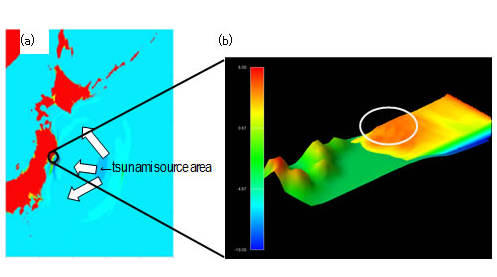A partnership between Fujitsu and Tohoku University has paid off in the form of a precise tsunami forecasting system that will help make Japan more resilient to disasters, such as the Great East Japan Earthquake of March 11, 2011, and the resulting tsunami that devastated the island nation.
A collaboration between Fujitsu Limited and Tohoku University that began in 2012 has resulted in a 3D tsunami simulator that can reproduce details such as the push of water into urban areas as well as potential river surges that could be caused by a tsunami.
The joint research project combines a 2D tsunami-propagation simulation technology developed by Professor Fumihiko Imamura, director of the International Research Institute of Disaster Science in Tohoku University, with Fujitsu’s 3D fluid simulation technology. As a result, researchers connected to the project can accurately replicate the complex changes a tsunami goes through as it interacts with coastal topography or buildings in urban areas.
The plan is to apply the simulator toward composite disaster forecasting of a tsunami caused by a major earthquake. To enable this strategy, the system will be brought into the Strategic Programs for Innovative Research (HPCI), which touts the powerful K supercomputer as its primary computing resource. HPCI is facilitated by MEXT, Japan’s Ministry of Education, Culture, Sports, Science and Technology. One of the themes of the program is improved tsunami forecasting techniques that would boost the country’s emergency preparedness.
Because of the tragic consequences of the 2011 disaster, Japan understands the great need to employ large-scale simulation technology to optimize building resiliency and to facilitate improved damage forecasting.
The 2D tsunami-propagation simulation technology developed by Tohoku University’s Professor Imamura is excellent for calculating the arrival time and wave height of a tsunami along coastal areas. But the program lacks the ability to simulate the water’s ingress into urban areas and rivers. Adding 3D data is challenging, but necessary to account for structures like buildings and levees which affect the tsunami’s behavior.
Fujitsu’s 3D fluid simulation technology uses a smoothed-particle hydrodynamic technique that treates fluid as a grid of particles. Thus it can model 3D behavior, like breaking waves and overflow. But going from 2D to 3D pushes computational demand significantly, espeically when the goal is to model a wide area extending from the tsunami source area to a coastal region.
Fujitsu and Tohoku University developed a new program that incorporated the data on wave height and flow velocity from the 2D tsunami-propagation simulation technology into the 3D fluid simulation technology. The result was a new 3D tsunami simulator that uses computational resources efficiently.
As the news release explains:
The action of the tsunami over the wide area extending from the hypocenter source to the coastal areas was replicated using the 2D simulation technology (figure 1 (a)), for which the computing loads are comparatively light, and the 3D fluid simulation technology was used just on the coastal regions and the urban areas, where such phenomena as wave breaks and overflow occur, enabling the 3D movements of the tsunami to be replicated within a period of time that is reasonable for practical use.
The newly devised 3D fluid simulation technology simulates the action of the tsunami in the coastal areas, which could not be done with either the 2D simulation technology or the 3D fluid simulation technology alone. With the increased simulation capability, Japanese officials hope to be able to predict the degree of damage caused by the impact force of the tsunami as it hits the shoreline.
A second benefit of having relatively light computing loads is that the time required for replication is greatly reduced, allowing mitigation efforts to more quickly assess an incoming threat.
To get a sense of the time-savings, Fujitsu explains that using only the 3D fluid simulation technology on a 10,000-node supercomputer system, it would take over 200 years to perform this kind of workload. The 3D tsunami simulator, on the other hand, is able to replicate a 0.5m radius in a tsunami traveling over approximately 10 square kilometers, which is equivalent to a typical harbor or bay, in about 160 hours on an equivalent computer.
The new simulator will be used in tandem with a variety of tsunami damage forecasting methods to create a disaster mitigation plan for western Japan. To assist the effort, Fujitsu said the company is working “to develop solutions that will support natural disaster reduction measures and be provided to the national and local governments.”




























































